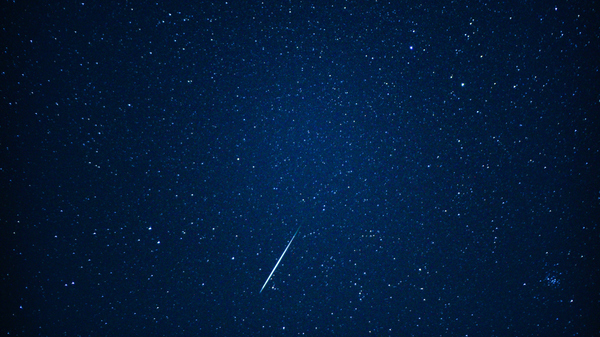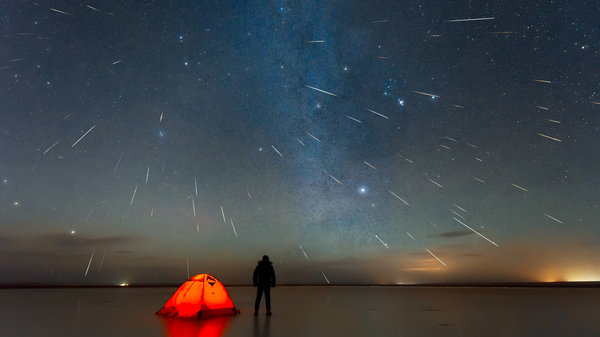Meteor vs. Meteorite
A meteor is an extraterrestrial rock streaking through our atmosphere, while a meteorite is the bit that survives the burn and crashes to Earth.

Shooting stars, also known as meteors, are usually bits of space rock burning through our atmosphere.
©iStockphoto.com/Toshiro Nakajima
Quadrantids 2025: No interference from Moon
Three Names for One Object
What we call a space rock depends on where it is–out in space, streaking through our atmosphere, or on the ground.
MeteoroidMeteoroids are chunks of rocky, sometimes metallic material zooming through space at speeds up to 100,000 miles (161,000 km) per hour. These bodies can be as tiny as a grain of sand or as large as a school bus, and spin out from comets, asteroids, moons, or planets.
MeteorWhen a meteoroid hits our atmosphere and ignites into the burning streak of light we call a shooting star, it becomes a meteor.
MeteoriteA meteorite is formed when a bit (usually about five percent) of the original meteoroid survives the harrowing trip through the atmosphere and comes crashing down to Earth.
Meteors are not asteroids, which are larger rocky objects that orbit a sun.
Hunting for Meteorites
Scientists consider meteorites to be great sources of information, and use advanced technology such as drones to seek them out. These alien rocks can help researchers understand the geology of other worlds, the history of our solar system, and the origin of asteroids.
But what about those of us without expensive, high-tech tools? How can we identify a meteorite if we come across one?
It's not easy to separate an extraterrestrial stone from an Earth rock in most places. You're much more likely to identify a bit of space debris in places with few other stones on the ground, such as deserts or icy tundra. That's why more meteorites have been discovered in Antarctica than in any other region.
What to Look For
If you do go out searching for space rocks, here are three basic characteristics to look for:
1. Search for stones that have a slightly shiny, burned appearance as a tell-tale sign of a journey through the heat of the atmosphere. This patina is known as a “fusion crust”.
2. If they contain a lot of iron, a magnet will stick to them.
3. Meteorites should be significantly heavier than typical Earth rocks for their size.
Meteor showers can create stunning displays. ©iStockphoto.com/bjdlzx
Nightly Showers of Light
As romantic as it seems to spot a meteor lighting up the sky, it's actually a pretty common event. In fact, estimates are that around 48.5 tons (44,000 kg) of meteoritic material falls to Earth every day, the vast majority of it in small particles like dust.
Sometimes, there can be a flurry of meteoric activity, or meteor shower. This display lights up when the Earth is moving through the debris trail left behind by asteroids or comets.
A few meteor showers have become widely known because they occur regularly. The Perseids, seen in early August, are born out of material generated from the Swift-Tuttle comet, which makes an enormous 135-year loop around the Sun. The Orionids are linked to the famed Halley's comet, and the Lyrids make an annual appearance every April.
Three Classes
Three classes of meteorites have been identified: Stony, Iron, and Stony-iron. Most of the time, recovered and identified meteorites belong to the heavier Iron category, since they are most likely to survive the fiery journey to the surface.
The color of a shooting star display can clue you in to what type of space rock has hit the sky. Yellow meteor displays indicate that the rock belongs to the Iron or Stony-iron class, while red hues indicate large percentages of nitrogen and oxygen, so most likely material from the Stony category.